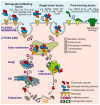Gaining New Insights into Fundamental Biological Pathways by Bacterial Toxin-Based Genetic Screens
- PMID: 37627769
- PMCID: PMC10451959
- DOI: 10.3390/bioengineering10080884
Gaining New Insights into Fundamental Biological Pathways by Bacterial Toxin-Based Genetic Screens
Abstract
Genetic screen technology has been applied to study the mechanism of action of bacterial toxins-a special class of virulence factors that contribute to the pathogenesis caused by bacterial infections. These screens aim to identify host factors that directly or indirectly facilitate toxin intoxication. Additionally, specific properties of certain toxins, such as membrane interaction, retrograde trafficking, and carbohydrate binding, provide robust probes to comprehensively investigate the lipid biosynthesis, membrane vesicle transport, and glycosylation pathways, respectively. This review specifically focuses on recent representative toxin-based genetic screens that have identified new players involved in and provided new insights into fundamental biological pathways, such as glycosphingolipid biosynthesis, protein glycosylation, and membrane vesicle trafficking pathways. Functionally characterizing these newly identified factors not only expands our current understanding of toxin biology but also enables a deeper comprehension of fundamental biological questions. Consequently, it stimulates the development of new therapeutic approaches targeting both bacterial infectious diseases and genetic disorders with defects in these factors and pathways.
Keywords: CRISPR-Cas9; Shiga toxins; bacterial toxin; cholera toxin; genetic screen; glycosphingolipids; large clostridial toxins; membrane vesicle trafficking; protein glycosylation; ricin.
Conflict of interest statement
The authors declare no conflict of interest.
Figures




Similar articles
-
Genome-wide CRISPR screens for Shiga toxins and ricin reveal Golgi proteins critical for glycosylation.PLoS Biol. 2018 Nov 27;16(11):e2006951. doi: 10.1371/journal.pbio.2006951. eCollection 2018 Nov. PLoS Biol. 2018. PMID: 30481169 Free PMC article.
-
Antibody-mediated inhibition of ricin toxin retrograde transport.mBio. 2014 Apr 8;5(2):e00995. doi: 10.1128/mBio.00995-13. mBio. 2014. PMID: 24713323 Free PMC article.
-
A Simple Fluorescence-based Reporter Assay to Identify Cellular Components Required for Ricin Toxin A Chain (RTA) Trafficking in Yeast.J Vis Exp. 2017 Dec 15;(130):56588. doi: 10.3791/56588. J Vis Exp. 2017. PMID: 29286473 Free PMC article.
-
Insights on the trafficking and retro-translocation of glycosphingolipid-binding bacterial toxins.Front Cell Infect Microbiol. 2012 Apr 11;2:51. doi: 10.3389/fcimb.2012.00051. eCollection 2012. Front Cell Infect Microbiol. 2012. PMID: 22919642 Free PMC article. Review.
-
Transport of protein toxins into cells: pathways used by ricin, cholera toxin and Shiga toxin.FEBS Lett. 2002 Oct 2;529(1):49-53. doi: 10.1016/s0014-5793(02)03182-4. FEBS Lett. 2002. PMID: 12354612 Review.
References
Publication types
Grants and funding
LinkOut - more resources
Full Text Sources

